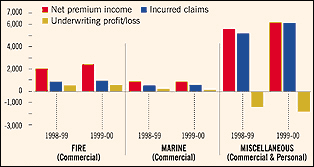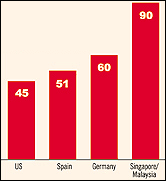The stage of development of general insurance
in India will also be a limiting factor. Unlike developed economies,
where a large part of insurance purchased is of a discretionary nature
and sales are driven by the customer recognising specific risks and
valuing coverage against those, most commercial insurance purchases
in India are driven by mandatory requirements. Such mandatory sales
transacted at tariff pricing between individuals with long-standing
relationships make the entry of a new channel difficult.
| GIC - Profitability
Hinges on Commercial Business |
| Profitable results
on fire and marine businesses partly "hide" the deficiencies
in other lines |
 |
|
Figures in Rs crore
Source: GIC Annual Reports, Monitor Analysis
|
Other factors such as a very high concentration
of insurable assets in a few sectors and in large corporate entities,
negligible penetration of ''retail commercial insurance'' driven
by a combination of low insurance awareness and financing of assets
through undeclared income, and poor experience with claims processing
will also impede the pace of development of the insurance industry
in general and alternate channels in particular.
Like in most situations, all challenges listed above can be viewed
as opportunities. However, to convert
the opportunity into profits, new entrants in insurance distribution
need to make considered choices in selecting their customers, the
portfolio of services they offer and the capabilities they need
to acquire or build.
First, it will be important to target the right
customer segments. Consider segmentation based on industry sector-most
of the old economy companies with traditional insurance needs are
being served reasonably well by GIC producers. However, as mentioned
earlier, emerging sectors such as software, telecom services, life
sciences and others are under-served. Next, if one were to segment
the universe of commercial insurance buyers on the basis of their
size, while the concentration of premiums in large corporate entities
make them an attractive target, these are the accounts that GIC
will compete most fiercely for. In contrast, the small and medium
enterprises will emerge as a group that is very dissatisfied with
both pre- and post-sale service standards of GIC companies (the
targets and incentive system for development officers and divisional
managers at GIC companies are based on growth in premium collection
and therefore the good producers do not "waste their time" on small
and medium enterprises) and may be an interesting segment for new
channels to focus on.
These are only two examples of segmentation. More importantly, segmentation
will have to be
| Unlike developed
economies, where a large part of insurance purchased is discretionary
in nature and sales driven by the customer recognising specific
risks, most commercial insurance purchases in India are driven
by mandatory requirements |
followed up by appropriate choices in (externally)
the range of services to be delivered and (internally) capabilities
to be developed.
Internationally, insurance brokerages are more
than just distribution intermediaries. Broking companies provide
a host of insurance-related services to their clients including
loss control, risk management, etc. While these are specialised
services, most Indian insurance customers get only ''seat-of-the-pants''
advise on these issues from sales employees of GIC. Based on selected
target customer segments, new intermediaries will have to assess
appetite for such services and provide these. Not only will this
add fee-based income to the intermediary (substantial portion of
income for international brokers), it also gives the new entrants
an opportunity to differentiate by adding significant value.
| Tied Agents
- Major Channel Globally |
| Even in countries
with developed multiple channels, tied agents own a large proportion
of life sales |
 |
Figures are share
in percentage of total life insurance sales
Source: MSDW, BancAm, Monitor Analysis |
Internally, customer segment and resultant service
range choices will mean acquiring or developing appropriate capabilities.
These relate to technical capabilities (do we focus on specific
industries and, therefore, recruit from relevant technology pools?),
insurance capabilities (is the focus on a particular line of business-say,
liability insurance?) and business capabilities (for example, what
partnering arrangements do we need to best address customer needs
or what geographic scope of activities is necessitated by segment
choice).
For any new entrant, it is critical to address these issues-making
integrated choices across these will help it win against incumbent
and emerging competition. Simultaneously, from an industry perspective,
entry of players who make such coordinated and distinct choices
will hasten the shift of premiums from high cost and inefficient
traditional channels to alternate ones-to the benefit of both insurance
carriers and their end-customers.
Nikhil Prasad Ojha is a Senior Principal at
The Monitor Group-a global strategy consulting firm founded by Michael
Porter. He is based in Mumbai and can be reached at Nikhil_Ojha@Monitor.com.
|

